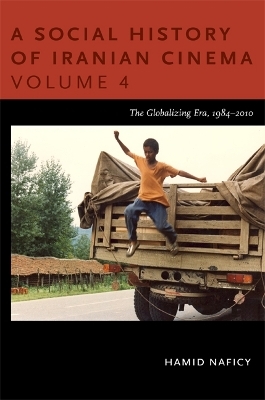
A Social History of Iranian Cinema, Volume 4
Duke University Press (Verlag)
978-0-8223-4878-8 (ISBN)
Hamid Naficy is one of the world's leading authorities on Iranian film, and A Social History of Iranian Cinema is his magnum opus. Covering the late nineteenth century to the early twenty-first and addressing documentaries, popular genres, and art films, it explains Iran's peculiar cinematic production modes, as well as the role of cinema and media in shaping modernity and a modern national identity in Iran. This comprehensive social history unfolds across four volumes, each of which can be appreciated on its own.The extraordinary efflorescence in Iranian film, TV, and the new media since the consolidation of the Islamic Revolution animates Volume 4. During this time, documentary films proliferated. Many filmmakers took as their subject the revolution and the bloody eight-year war with Iraq; others critiqued postrevolution society. The strong presence of women on screen and behind the camera led to a dynamic women's cinema. A dissident art-house cinema—involving some of the best Pahlavi-era new-wave directors and a younger generation of innovative postrevolution directors—placed Iranian cinema on the map of world cinemas, bringing prestige to Iranians at home and abroad. A struggle over cinema, media, culture, and, ultimately, the legitimacy of the Islamic Republic, emerged and intensified. The media became a contested site of public diplomacy as the Islamic Republic regime as well as foreign governments antagonistic to it sought to harness Iranian popular culture and media toward their own ends, within and outside of Iran. The broad international circulation of films made in Iran and its diaspora, the vast dispersion of media-savvy filmmakers abroad, and new filmmaking and communication technologies helped to globalize Iranian cinema.
A Social History of Iranian Cinema
Volume 1: The Artisanal Era, 1897–1941
Volume 2: The Industrializing Years, 1941–1978
Volume 3: The Islamicate Period, 1978–1984
Volume 4: The Globalizing Era, 1984–2010
Hamid Naficy is Professor of Radio-Television-Film and the Hamad Bin Khalifa Al-Thani Professor in Communication at Northwestern University. He is the author of An Accented Cinema: Exilic and Diasporic Filmmaking, The Making of Exile Cultures: Iranian Television in Los Angeles, and (in Persian) Film-e Mostanad, a two-volume history of nonfiction cinema around the world. Naficy helped to launch ongoing annual Iranian film festivals in Los Angeles and Houston.
Illustrations xi
Acknowledgments xv
Organization of the Volumes xxi
A Word about Illustrations xxvii
Abbreviations xxix
1. The Resurgence of Nonfiction Cinema: Postrevolutionary Documentaries and Fiction War Films 1
2. Under Cover, on Screen: Women's Representation and Women's Cinema 92
3. All Certainties Melt into Thin Air: Art-House Cinema, a "Postal" Cinema 175
4. Emergent Contestatory Films, Media Culture, and Public Diplomacy 269
5. Iranian, but with a Different Accent: A Cinema of Displacement or a Displaced Cinema? 369
Appendix A: Iranian Films in Distribution 513
Appendix B: Film House of Iran's Film Collection 515
Appendix C: International Film and Video Center Iranian Film Collection 520
Notes 523
Bibliography 559
Index 591
| Zusatzinfo | 112 photographs |
|---|---|
| Verlagsort | North Carolina |
| Sprache | englisch |
| Gewicht | 934 g |
| Themenwelt | Kunst / Musik / Theater ► Film / TV |
| Geisteswissenschaften ► Geschichte ► Regional- / Ländergeschichte | |
| Geschichte ► Teilgebiete der Geschichte ► Kulturgeschichte | |
| Geschichte ► Teilgebiete der Geschichte ► Sozialgeschichte | |
| Sozialwissenschaften ► Kommunikation / Medien ► Medienwissenschaft | |
| ISBN-10 | 0-8223-4878-0 / 0822348780 |
| ISBN-13 | 978-0-8223-4878-8 / 9780822348788 |
| Zustand | Neuware |
| Haben Sie eine Frage zum Produkt? |
aus dem Bereich


